Small Blue Bird With White Belly and Crest in San Antonio
You spotted a blue bird (blue-colored bird to be more exact) in Texas – but what is it? There are many blue-colored birds inTexas so it's not surprising you've seen one. The next step is to identify it. I got you!
With more than 20 years of experience attracting backyard birds to my yard (Wisconsin), I've studied all of the blue-colored birds in my area so I have the information you're looking for. For the remaining blue-colored bird species, I rely on my trusty sourcebooks and friends at The Cornell Lab of Ornithology to guide me.
I'll never forget my first blue-colored bird spotting – which I later learned was an Indigo Bunting! You'd have thought I'd seen Elvis in my backyard. I screamed "blue bird, blue bird" and ran around my house like a lunatic looking for my camera. It was still there when I returned, but not for long. I looked him up in my guide book and there he was in all his royal blue glory. Breathtaking.
My hope is that you'll be able to easily identify the blue bird you saw or plan to see in my article. Here you'll find all types of wild blue birds (species) found in Texas. They could be all blue or blue with a secondary color. They could be tiny blue birds, small blue birds, large blue birds, bright blue birds, dark blue birds, and light blue birds. Some blue birds are in south Texas, others in north Texas, east and west. They're all here!
Some blue-colored birds live inTexas year-round, others are here to breed, and others are migrating through. The range maps are color-coded so you know if it's a year-round bird, there to breed, migrating through, or there during a nonbreeding time.

I also included a beautiful closeup photo to help you identify these blue beauties along with detail such as:
- Size + appearance description
- Diet in the wild and at the feeder
- Habitat
- Nest & eggs description
So let's get at it, here are the blue-colored birds in Texas:
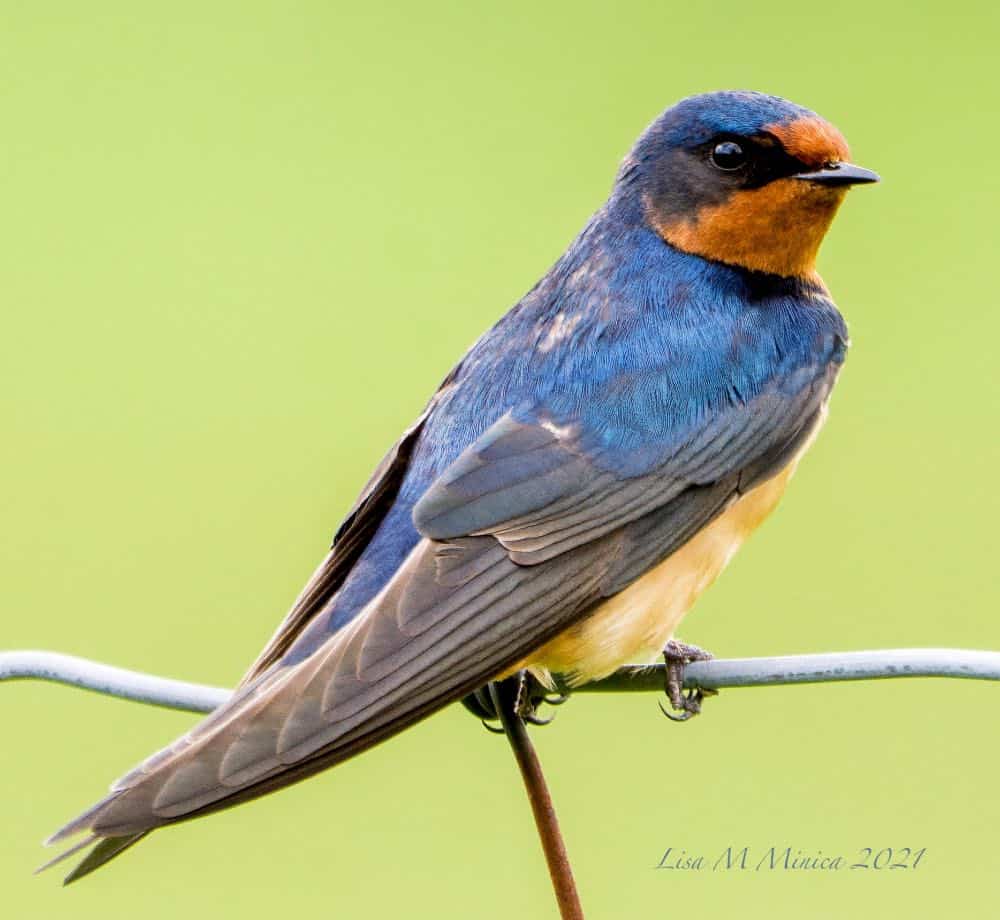
| Appearance | 7″ long, steel blue glossy on top, chestnut forehead and throat, and rust-orange underparts. Long forked tail with a white base. The female's coloring is lighter and the tail shorter. |
| Diet | Insects, preferably beetles, wasps, and flies. Drinks by skimming the surface of the water. |
| Feeder Food | Not likely to visit a feeder. |
| Habitat | Open fields and pastures. |
| Nesting | Typically nests in or on a manmade structure such as a barn. Builds nests of mud. 2 broods/season, 4-5 eggs per brood, eggs are white with brown markings, incubation from 13-17 days. |
Range Map
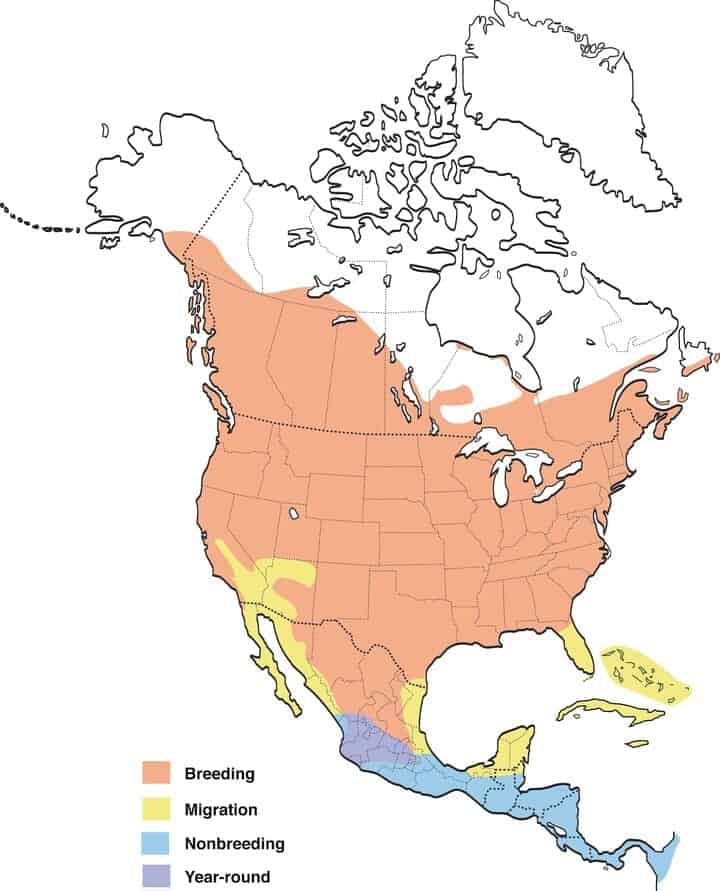
| Appearance | Large 13″ long bird with a large head, long bill, and stocky body. Blue/gray throughout with white ring around neck and white chest. Female is same but with additional chestnut band on chest. |
| Diet | Mostly fish with some crustaceans, insects, amphibians, reptiles, young birds, small mammals, and berries. |
| Feeder Food | Unlikely to come to the feeder but often attracted to yards with streams or ponds. |
| Habitat | Near streams, rivers, ponds, lakes, and calm marine waters – especially unclouded water with little vegetation. |
| Nesting | Dig burrows along waters edge. 1-2 broods/season, 5-8 eggs/brood – large white glossy eggs (1.5″ long), 22-24 days incubation. |
Range Map
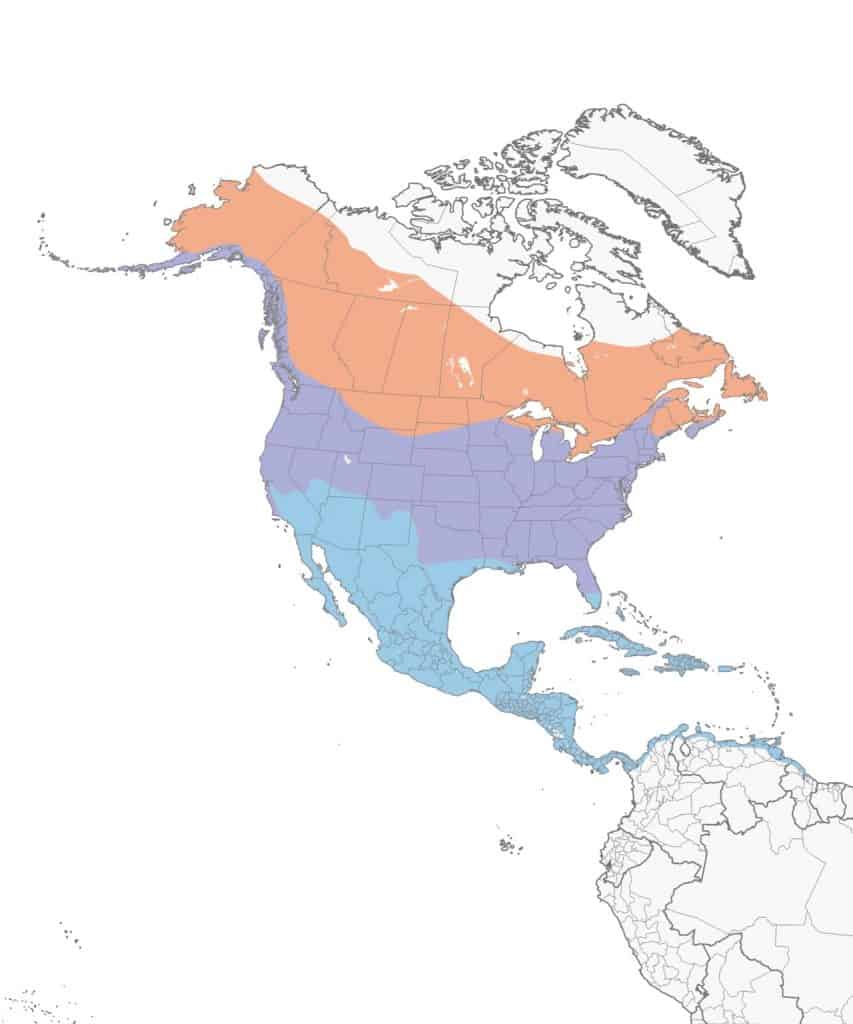
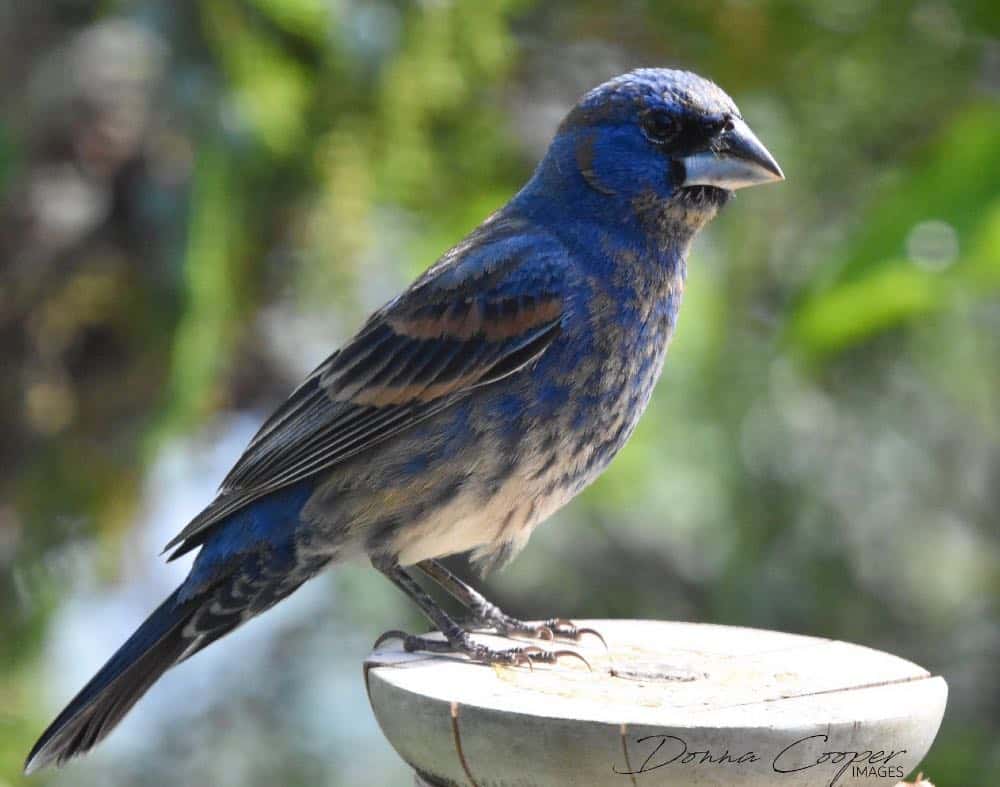
| Appearance | 8″ long, large, bright blue, large silver bill, and chestnut wingbars, Female's primary color is light cinnamon with darker colored wings. |
| Diet | Insects, seeds, and grains. |
| Feeder Food | Grain and birdseed. |
| Habitat | Thick shrubbery and areas with tall trees. |
| Nesting | Nest: Small cup-shaped nest of twigs and miscellaneous organic materials resting in low-lying trees, shrubs, and bushes. Brood: 1-2 broods/season Clutch: 3-5 eggs/brood Egg color: Pale blue to white with occasional brown spots Egg size: 0.8 inches by 0.7 inches Incubation: 12-13 days incubation. |
Range Map
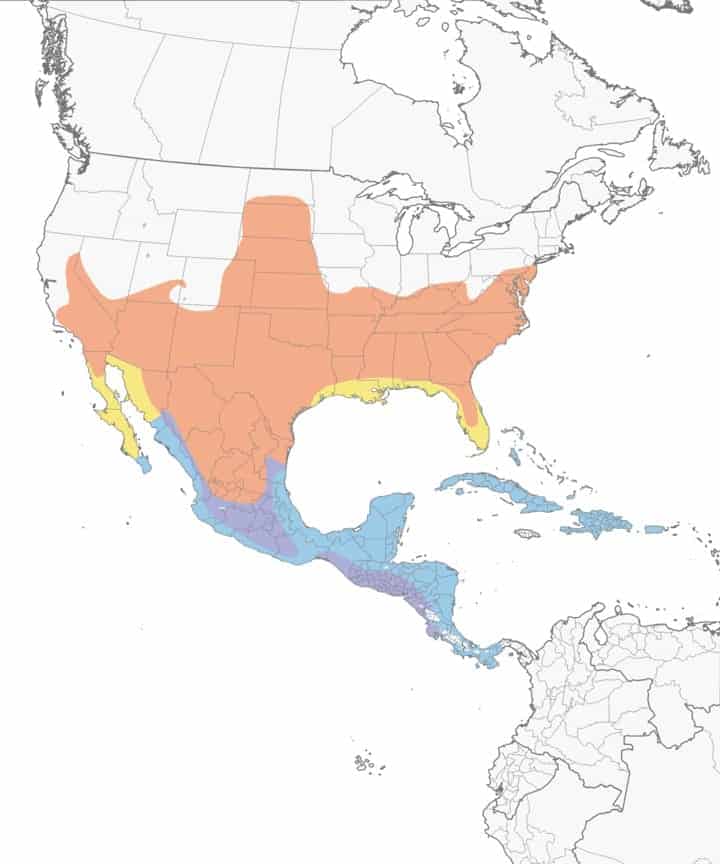
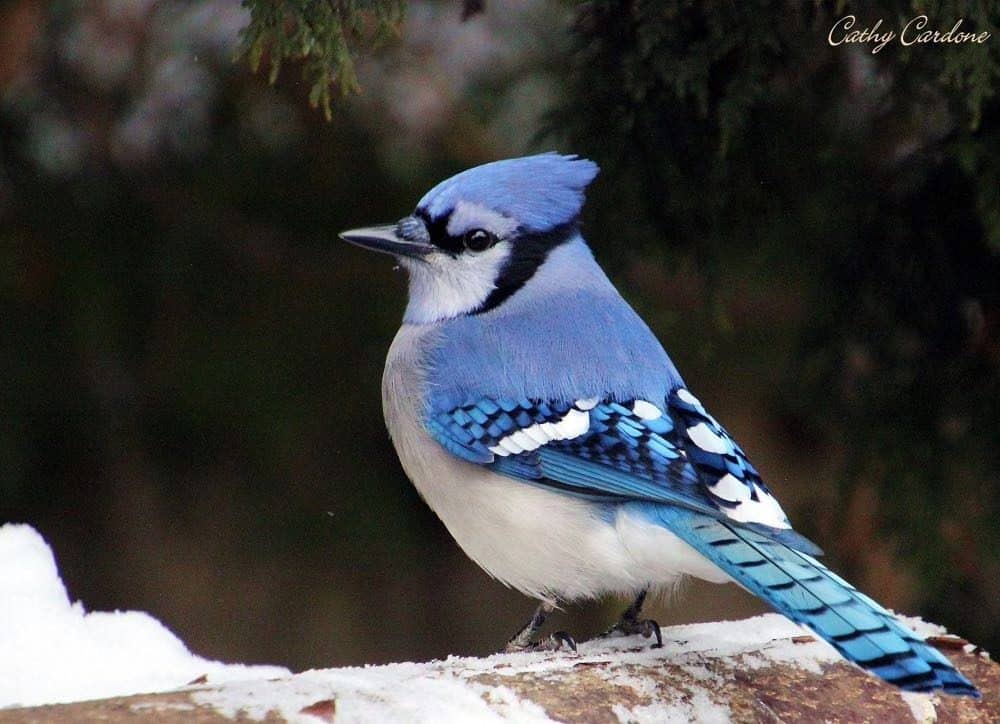
| Appearance | Large bird 12″ long, medium blue & white body, blue crest (which he flattens at will), gray belly and white face. White & blue wings with black spots. Female look the same. |
| Diet | Insects, fruit, seeds, nuts, other birds' eggs and nestlings. |
| Feeder Food | Whole peanuts, sunflower seeds, and cracked corn. |
| Habitat | Forested areas with mixed trees types. Also common in suburbs and urban areas. |
| Nesting | Nest: bulky large nest made from twigs, bark, and mud resting on a tree branch about 5-50′ up. Broods: 1-2 broods/season, Clutch: 2-7 eggs/brood, Egg color: Pale blue to a light brown base color, and these eggs usually have brown or gray spots. Egg size: 1 inch by just under 1 inch Incubation: Both parents incubate the eggs for 17-18 days and the young fledge between 17-21 days. |
Range Map
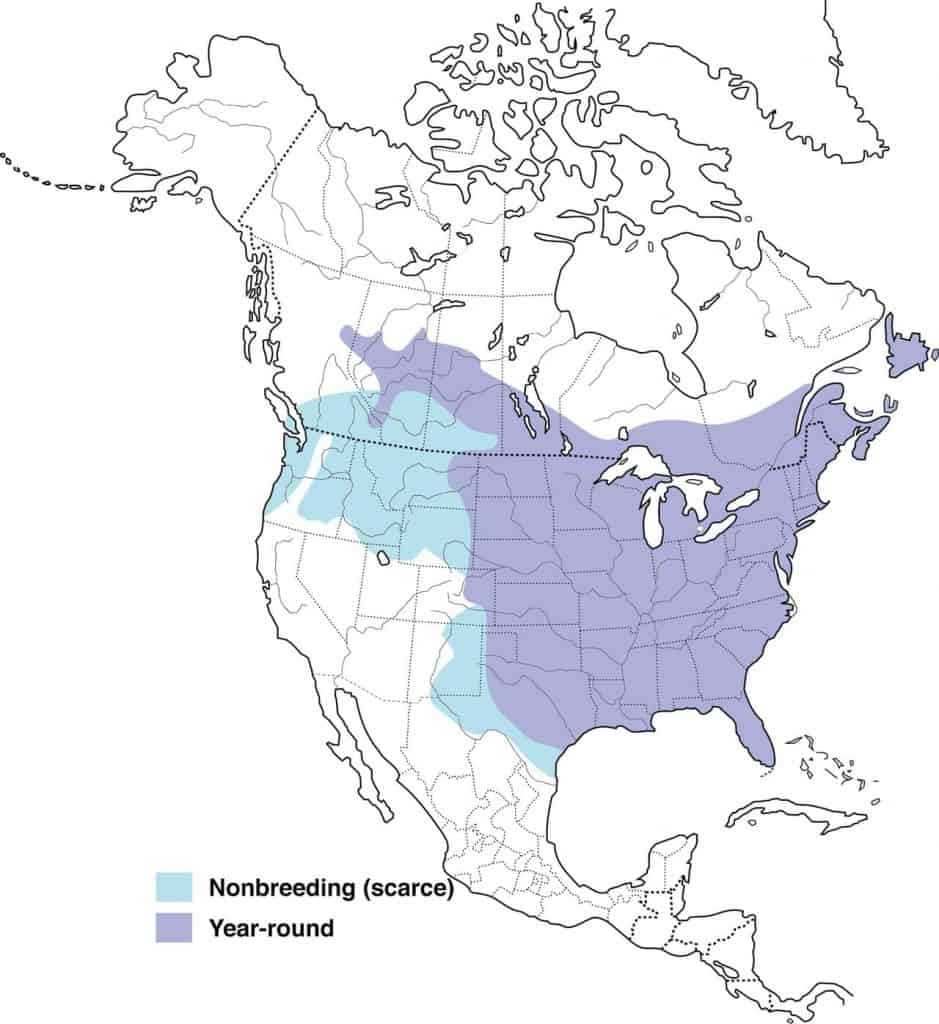
Wouldn't you love to have blue jays in your yard? Check out: 7 Proven Ways to Attract Blue Jays to Your Yard.
| Appearance | Tiny birds 4.25″ long, soft blue/gray upperparts, white eye-rings, white underparts, long black long tail with white under. Females are the same. The breeding male is accented with narrow black eyebrows. |
| Diet | Insects and spiders. |
| Feeder Food | Unlikely to visit the feeder. |
| Habitat | Deciduous forested areas. |
| Nesting | Nest: Tidy cup-shaped nest of natural fibers, bark, and spiderweb about 3-80′ high in a tree or shrub. Broods: 1-2 broods/season Clutch: 3-5 eggs/brood Egg color: Pale blue with red/brown spots. Egg size: 0.5 – 0.6 inches by 0.4 – 0.5 inches Incubation: 11-15 days and the young fledge at about 10-15 days. |
Range Map
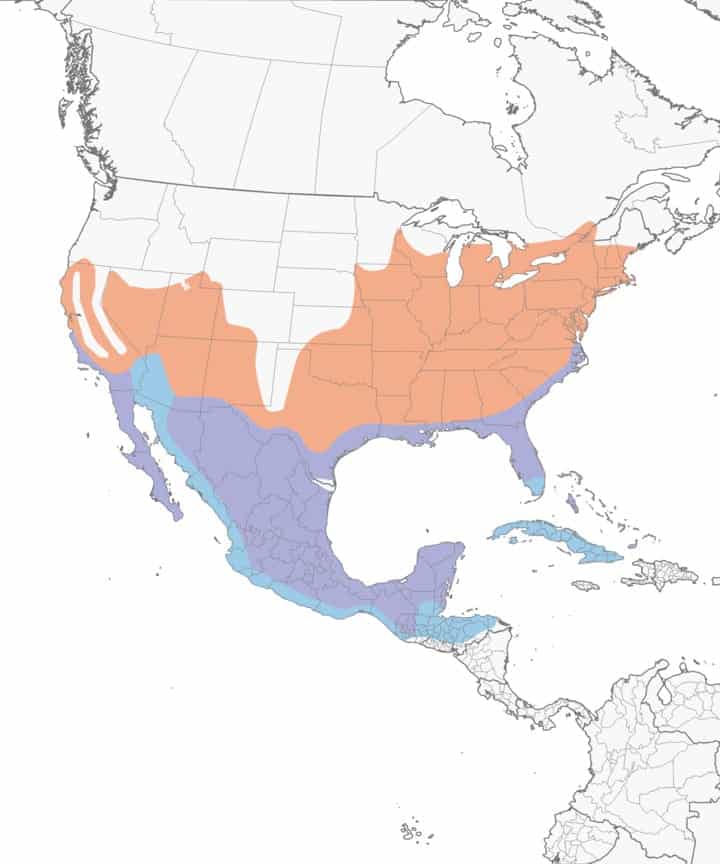
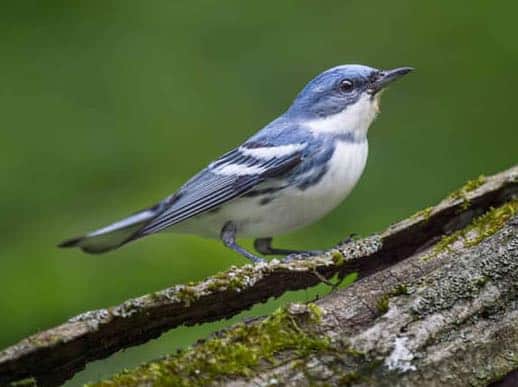
| Appearance | Small 4.3″ long bird, sky-blue above, white wing bars, darker blue streaks on back, white belly, steel/blue neck band & stripes on the sides. Females are light blue/green above, soft yellow belly, brown wings, and a bit of white under the eye. |
| Diet | Insects and plants. |
| Feeder Food | Unlikely to visit feeder. |
| Habitat | Deciduous forests with mature tall trees. |
| Nesting | Cup-shaped nests of twigs, grass and spiderwebs placed in tree 16-115′ up. 1 brood/season, 1-5 eggs/brood, eggs are .6-.8″ long, gray/green and speckled with brown, incubation lasts 11-12 days. |
Range Map
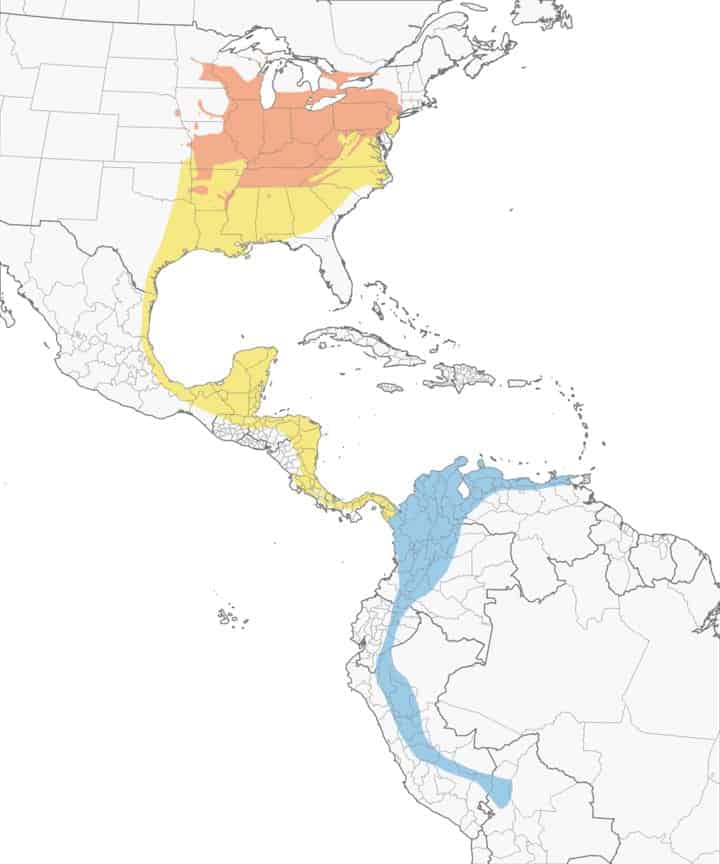
| Appearance | 12.5″ long bird with iridescent blue with purple and bronze. Eyes are yellow, long flared tail. Female is similar with less vibrant coloring (more brown) and shorter tail. |
| Diet | Insects, grains, seeds, fruit, scavenged garbage. |
| Feeder Food | Sunflower seeds, black-oil sunflower seeds. |
| Habitat | Fields with scattered trees, open woodlands, farmlands, and marshes. Common in suburban yards. |
| Nesting | Bulky cup-shaped nest of twigs placed 3-20′ high in conifer tree. 3-5 eggs incubated for 12-15 days. Young fledge at about 12-15 days. |
Range Map
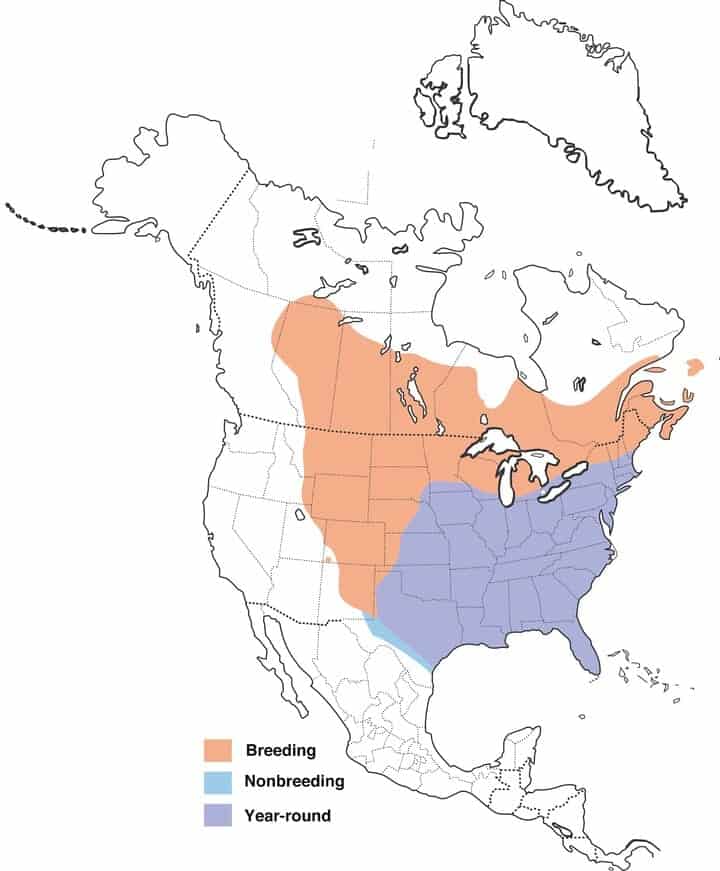
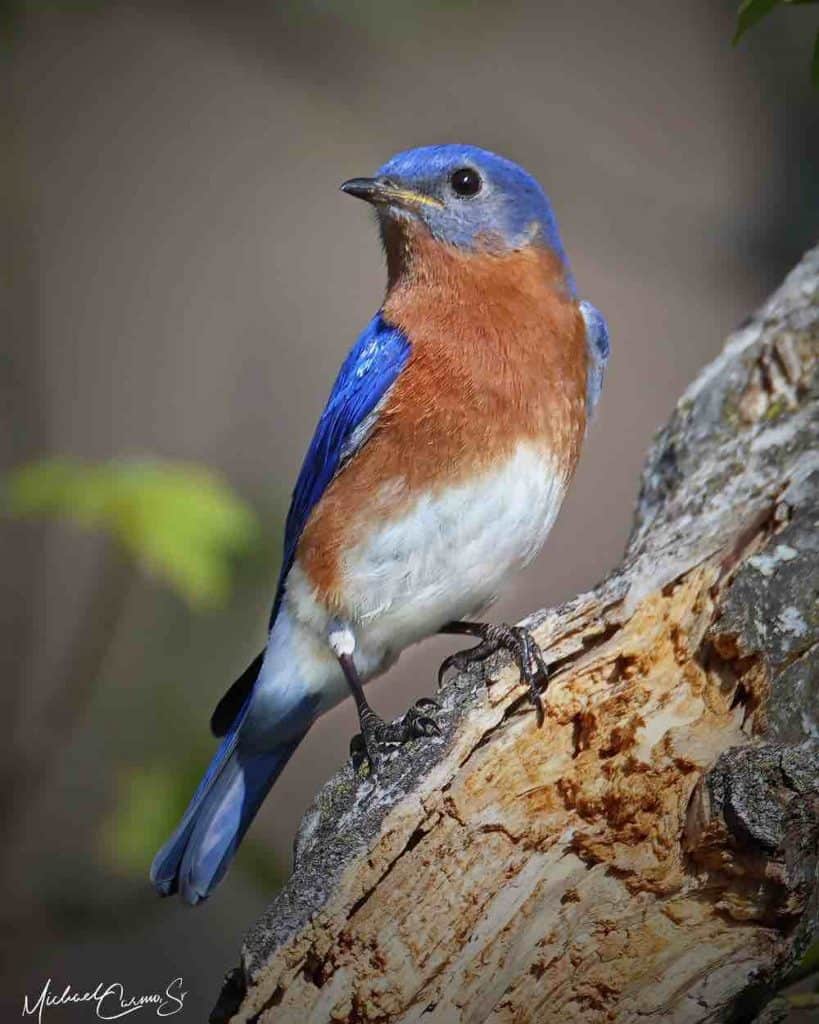
| Appearance | 7″ long, royal blue, orange throat & breast, white belly & undertail. Female is similar but more muted colors |
| Diet | Insects & spiders in spring/summer. Small fruit in Fall/Winter. |
| Feeder Food | Suet, sunflower seeds, dried fruit, jelly. |
| Habitat | Wide-open spaces, fields, meadow. |
| Nesting | Nest: Cavity nesters. The male bluebird determines the nest site (an old woodpecker hole in a tree or manmade nestbox), but the female is the one who builds the nest. She keeps the nest for multiple broods. Brood: 2-7 broods/season Clutch: 4-5 eggs/brood Egg color: Pale blue eggs (sometimes white) with no blemishes or discoloration. Egg size: 0.9 inches by 0.8 inches Incubation: 11-19 days |
Range Map
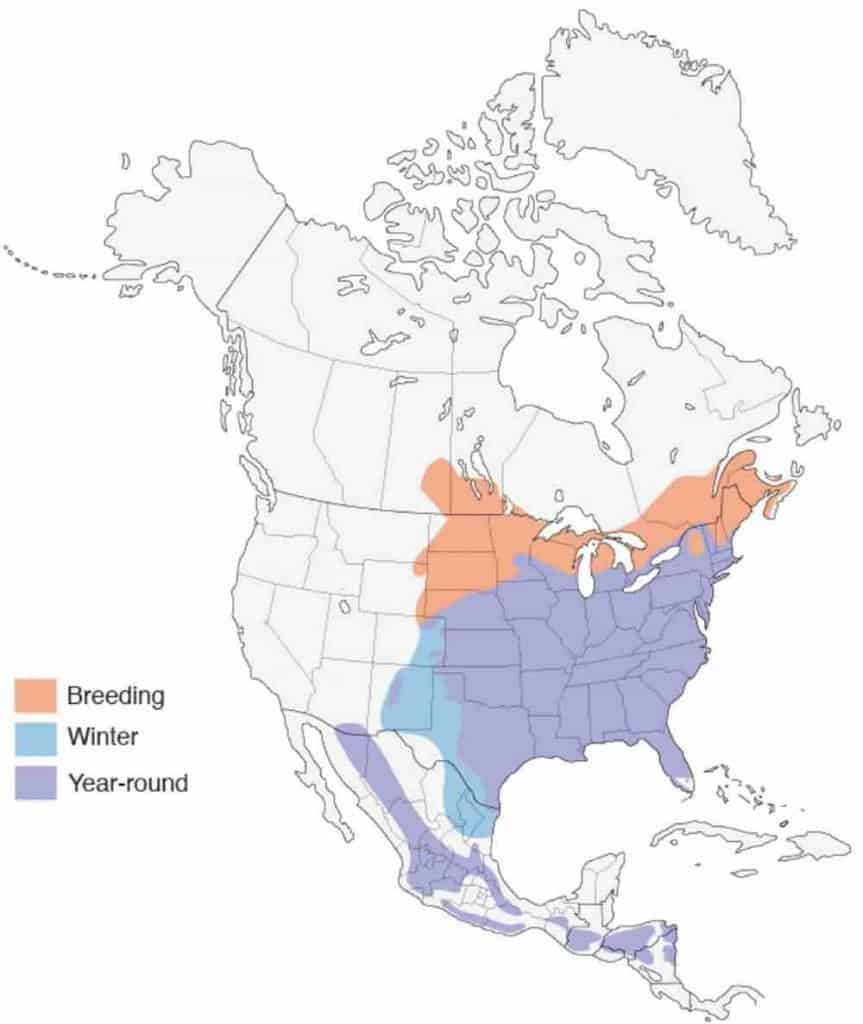
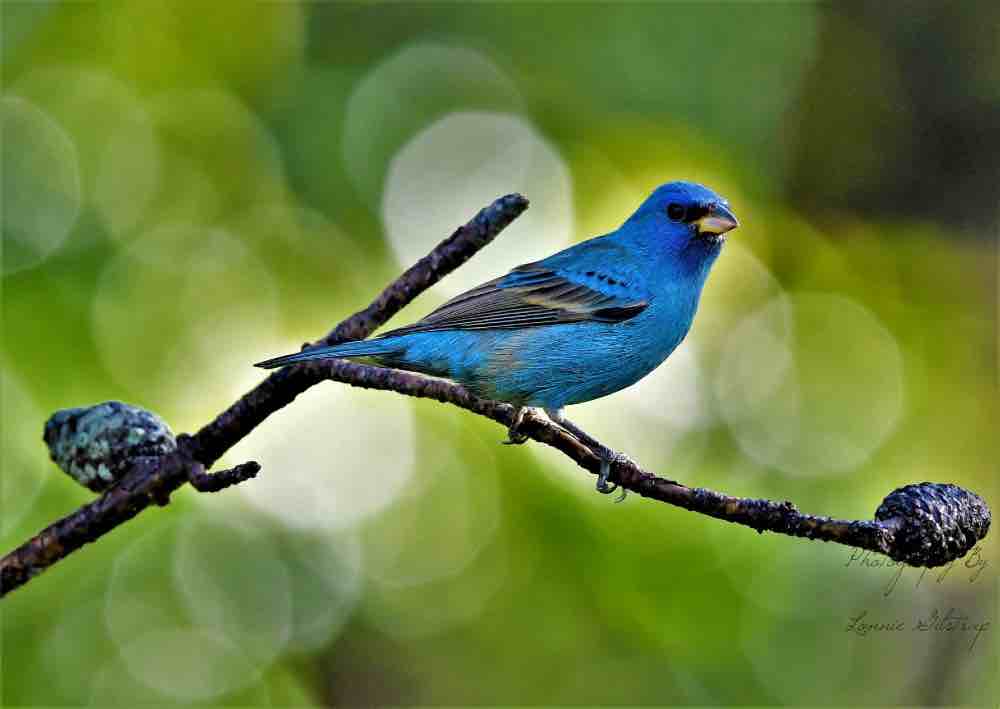
| Appearance | Small bird 5″ long. Breeding males are bright blue with short, gray, triangle-shaped beaks, and dark blue wings with a brush of tan. Wintering male and first-spring male are patchy brown and blue. Females are a soft yellowish-brown and some light streaking on the underparts. |
| Diet | Small seeds, insects, and fruits. |
| Feeder Food | Although not a regular at the feeder you may entice them with nyjer/thistle and white millet seeds. |
| Habitat | Brushy fields, on weedy plants, scrub, and along the edges of the woods. Also in clearings within deciduous woods, and edges of swamps. |
| Nesting | Cup-shaped nest in shrubs or trees 3′ high. Shrubs or trees 3′ high. 1-3 broods/season, 3-4 eggs/brood, eggs are white with few brown spots. |
Range Map
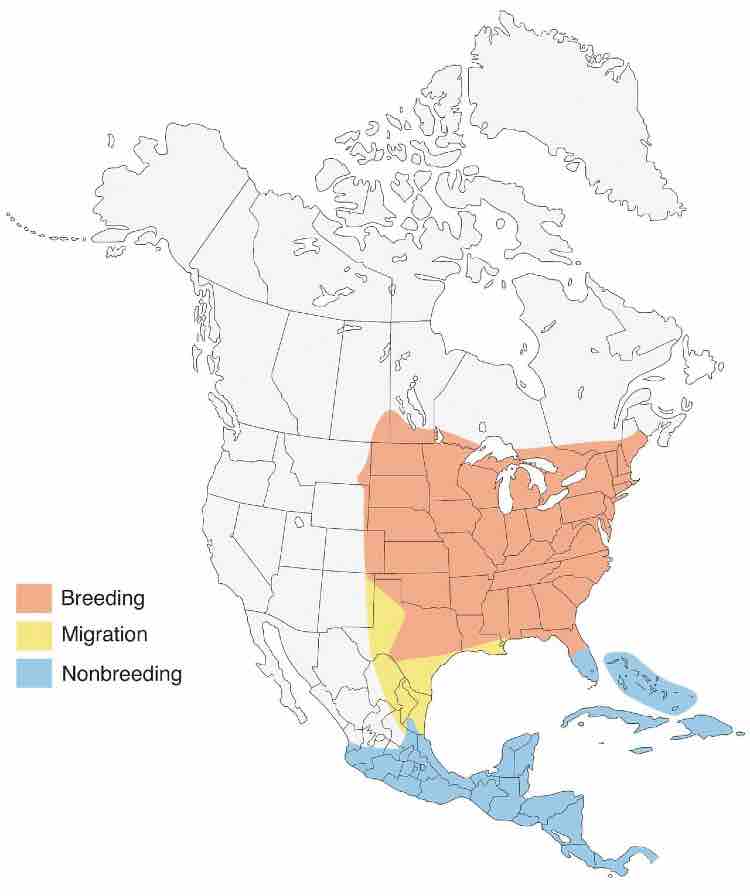
For more detail about the Indigo Bunting such as its mating & nesting, how to attract them to your yard, andmore: check out Proven Ways to Attract Indigo Buntings.
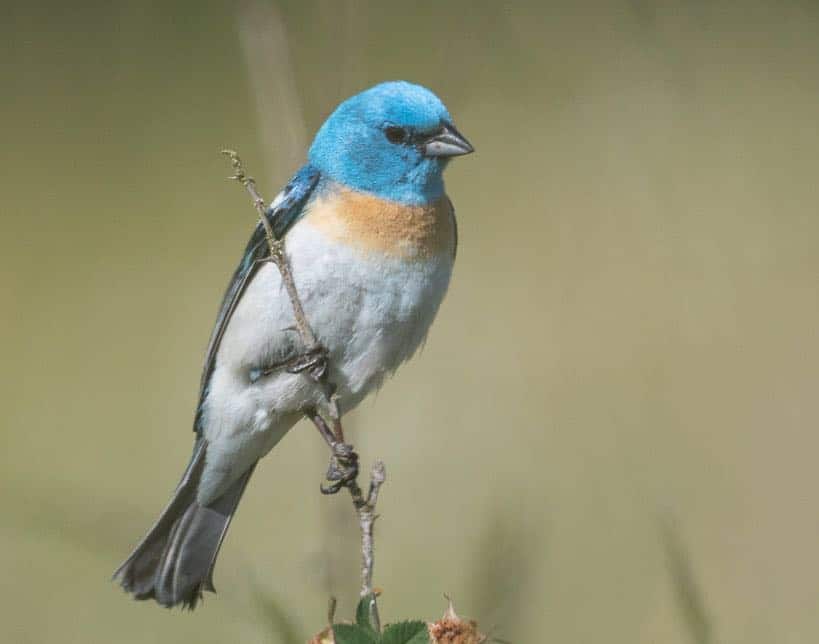
| Appearance | Small bird 5-6″ long, brilliant blue on top, soft orange-cinnamon color chest, white belly and patch on the shoulder, cone-shaped bill, and slightly flat forehead. |
| Diet | Insects, fruits, and grasses. |
| Feeder Food | White proso millet, sunflower seeds, or nyjer thistle seeds. |
| Habitat | Open woodlands, brushy hillsides, thickets, and backyards throughout the West. |
| Nesting | Cup-shaped nest of bark, twigs, and leaves nestled in a shrub about 3′ up. They have 1-2 broods/season, 3-4 eggs/brood, and eggs are .7-.8″ long and pale blue to faint green/blue or white. 11-14 days incubation period. |
Range Map
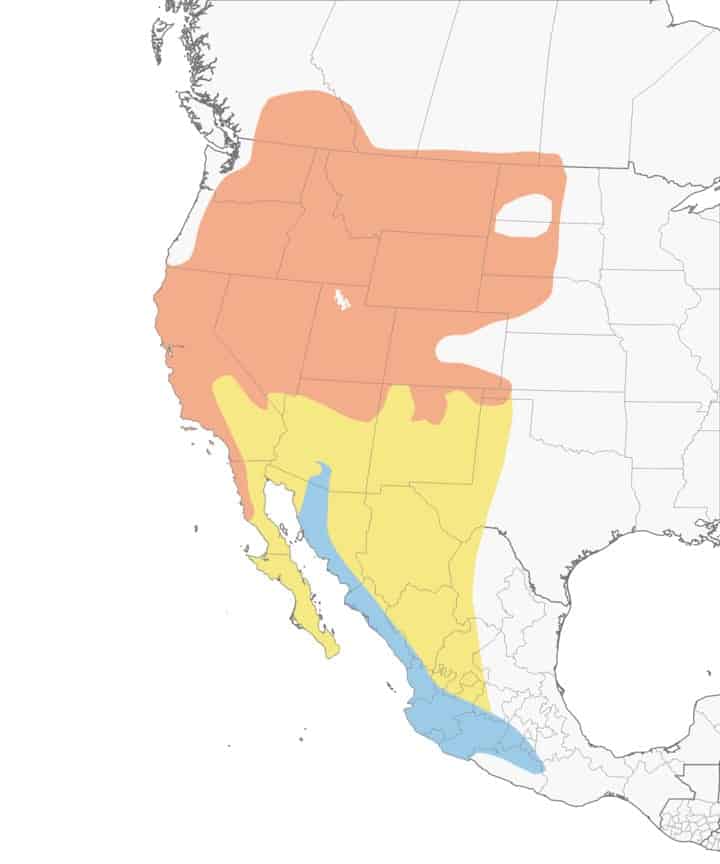
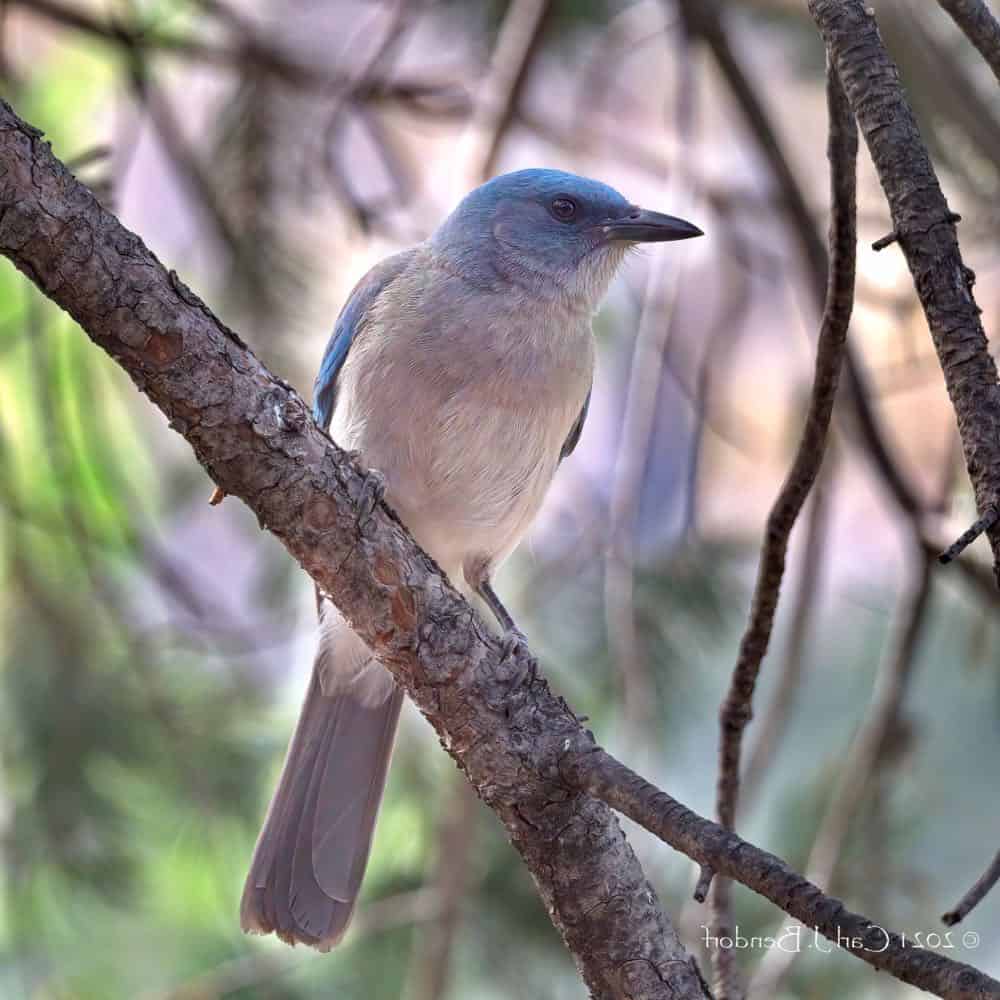
| Appearance | 11.5″ long, large blue bird with gray/blue back, soft white underparts and long tail. |
| Diet | Acorns, pinyon nuts, insects, spiders and lizards. |
| Feeder Food | N/A |
| Habitat | Open woodlands near pinyon and oak trees. |
| Nesting | Cup-shaped nest of twigs located tree. 1-6 eggs, eggs are green with dark markings but some have no markings. |
Range Map
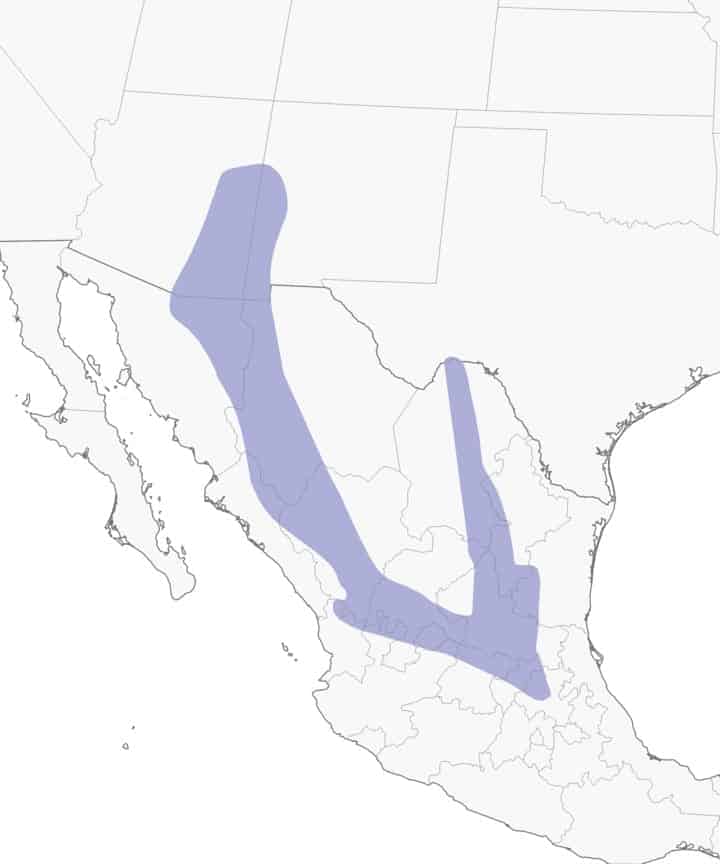
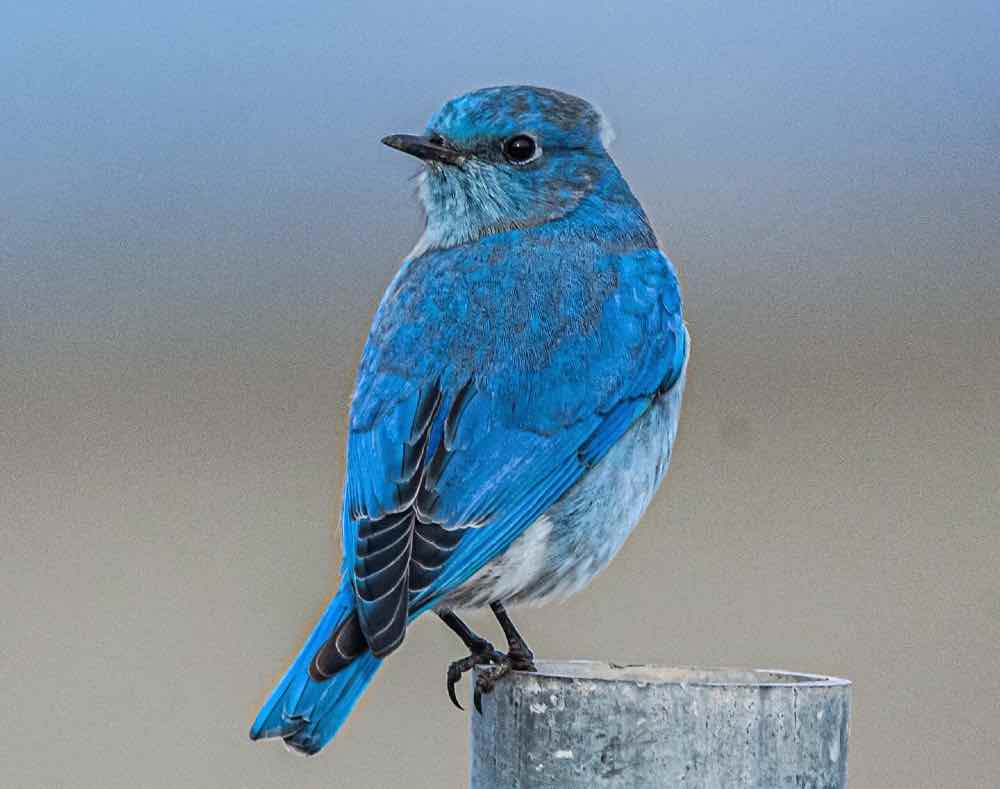
| Appearance | Small bird about 7″ long. Sky-blue color, darker blue wings and tail, lighter shades of below underneath, white undertail with black wing tips, and straight thin bill. Females are gray/brown with a big of soft blue on their wings and tail. |
| Diet | Insects, fruit, and seeds. |
| Feeder Food | Unlikely to visit a feeder. |
| Habitat | Open woodlands, fields, prairies. |
| Nesting | Nest: Cavity nesters – will use an old woodpecker hold or manmade nesting box. Brood: 1-2 broods/season Clutch: 4-8 eggs/brood Egg size: 1″ x .8″ Egg color: Pale blue to bluish-white (rarely pure white) Incubation: 18-21 days |
Range Map
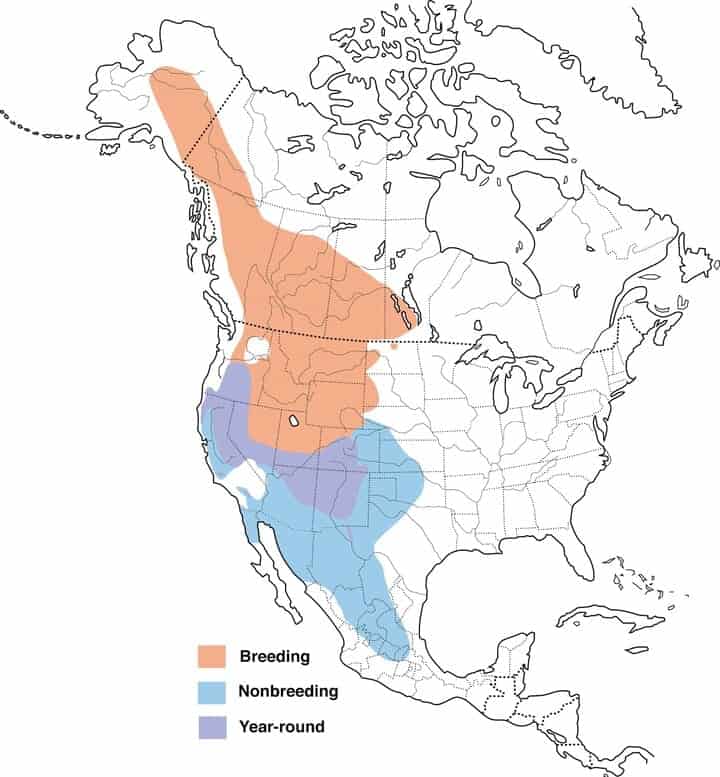

| Appearance | Small bird about 4.5″ long, blue/gray with a yellow throat and back patch, bluish-gray overall with a yellow-green patch on the back, a brown band on lower, white strips above and below each eye. Females are similar but more muted colors. neck, and 2 white wing bars. |
| Diet | Spiders, insects, berries, seeds, nectar. |
| Feeder Food | Unlikely to visit a feeder. |
| Habitat | Prefer forested areas especially when water is present (streams, marshes) and in the lowland where moss is present. |
| Nesting | Nests are built in mossy vegetation as high up as 100′ at the end of a branch. 1-2 broods/season, 2-7 eggs/brood, eggs are about .65″ long, white with red/brown/purple speckles and incubation lasts about 12-14 days. |
Range Map
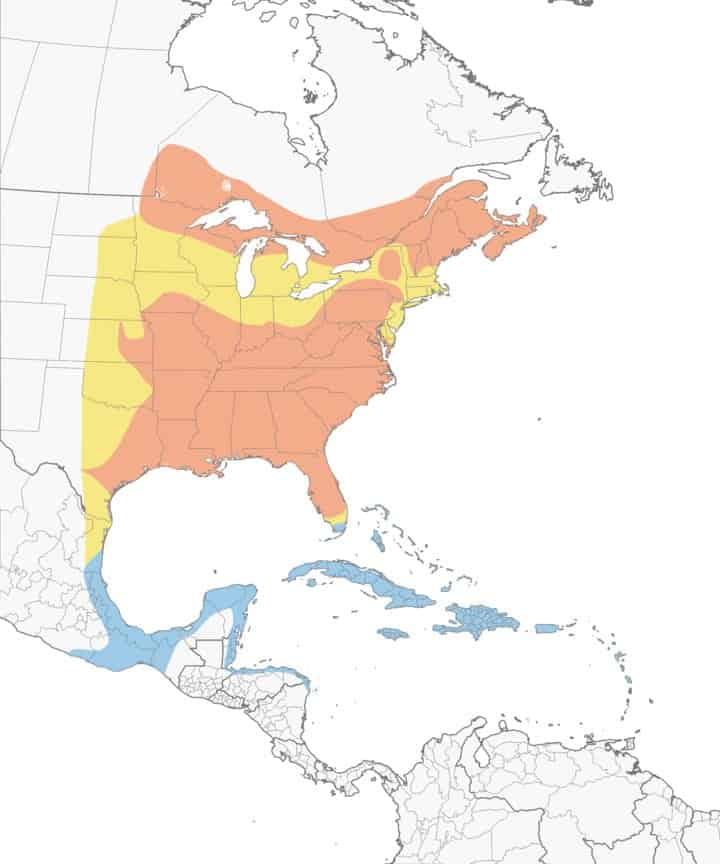
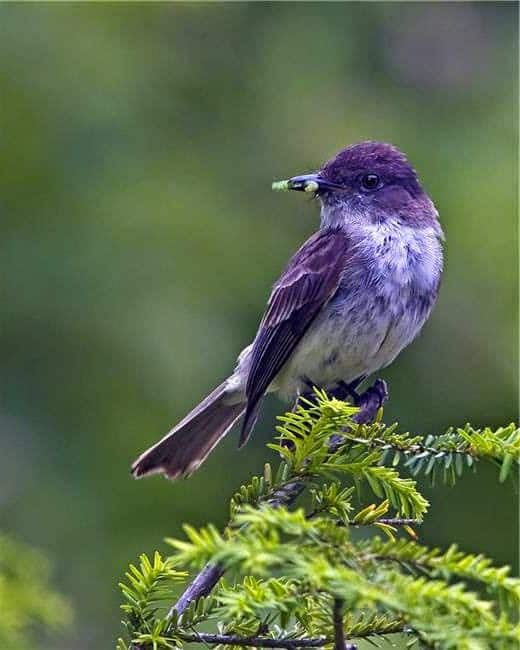
| Appearance | 8.5″ large bird with blue/purple head, back, and belly with black wings and tail. |
| Diet | Insects especially dragonflies. |
| Feeder Food | Unlikely to visit a feeder. |
| Habitat | Usually within 100′ of human dwelling. Purple Martins exist in large colonies. |
| Nesting | Cavity nester primarily using manmade nest boxes which accommodate a colony of birds. 1 brood/season, 4-5 white eggs/brood, 15-18 days incubation, fledge after 26-30 days. |
Range Map
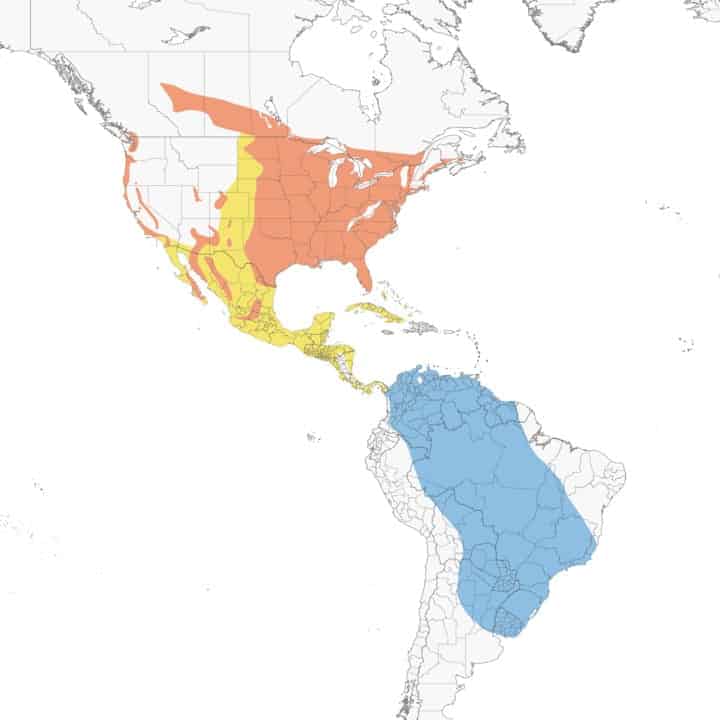
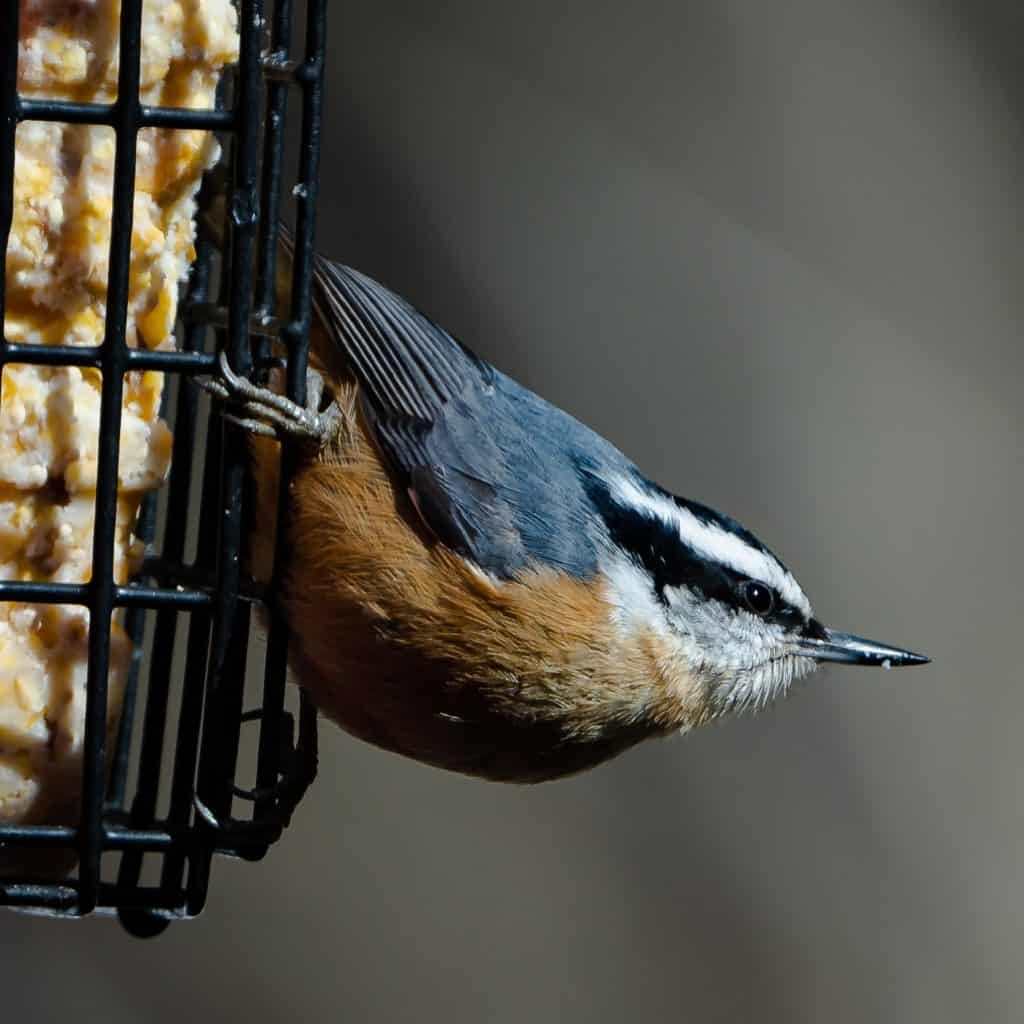
| Appearance | 4.5″ long, gray/blue backs, white head with black stripes running over either eye, orange-cinnamon-colored breast, and a pointy pick-like beak. Females look the same except their underside is a more faded color. Usually spotted climbing upside-down a deciduous tree foraging for insects beneath the bark. |
| Diet | Insects, spiders, and other bugs. |
| Feeder Food | Suet, sunflower seeds, shelled peanuts, fruit. |
| Habitat | Forested areas primarily comprised of coniferous trees (i.e. pines). Woodsy areas of deciduous trees in the east. Southern birds prefer mountainous regions until winter comes in which case they head to lower land. |
| Nesting | Cavity nesters – prefer to excavate their own holes. 1 brood/season, 6 eggs/brood, eggs are white & speckled with red-brown. |
Range Map
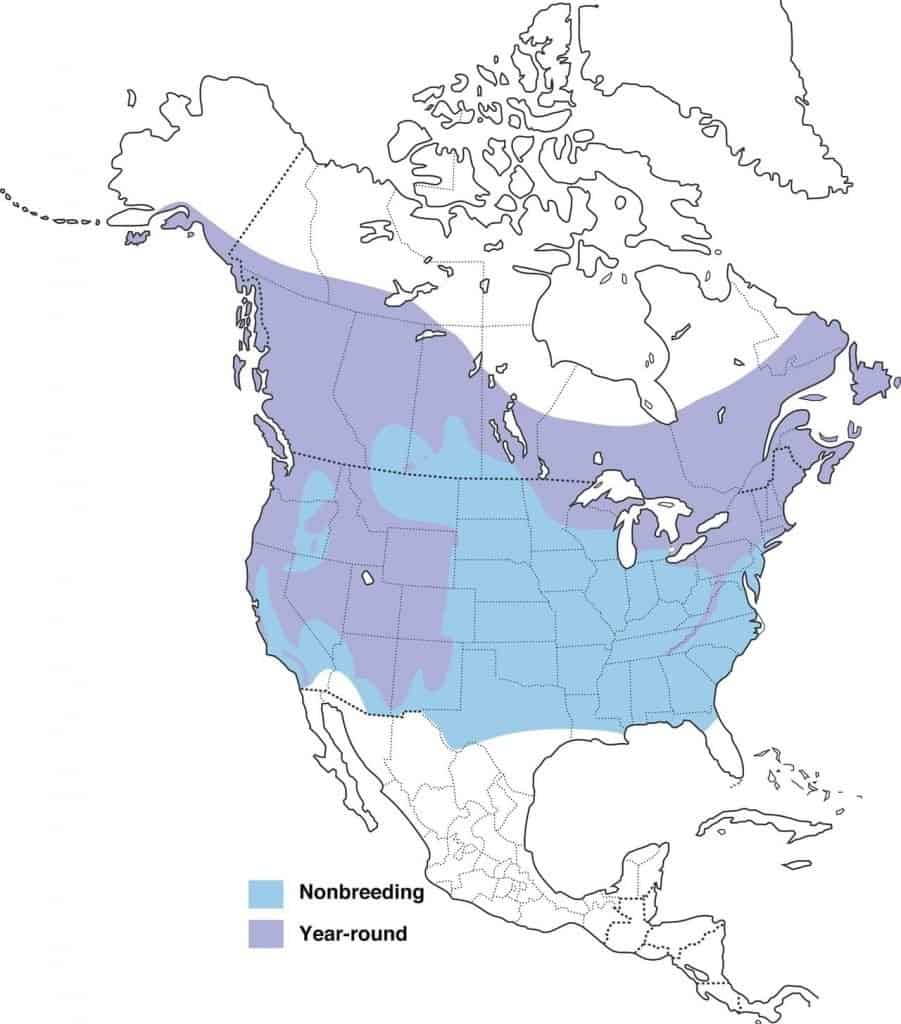
For more details about the Red-Breasted Nuthatch such as its mating & nesting details, how to attract them to your yard, andmore: check out 7 Ways to Attract Red Breasted Nuthatches to Your Yard.
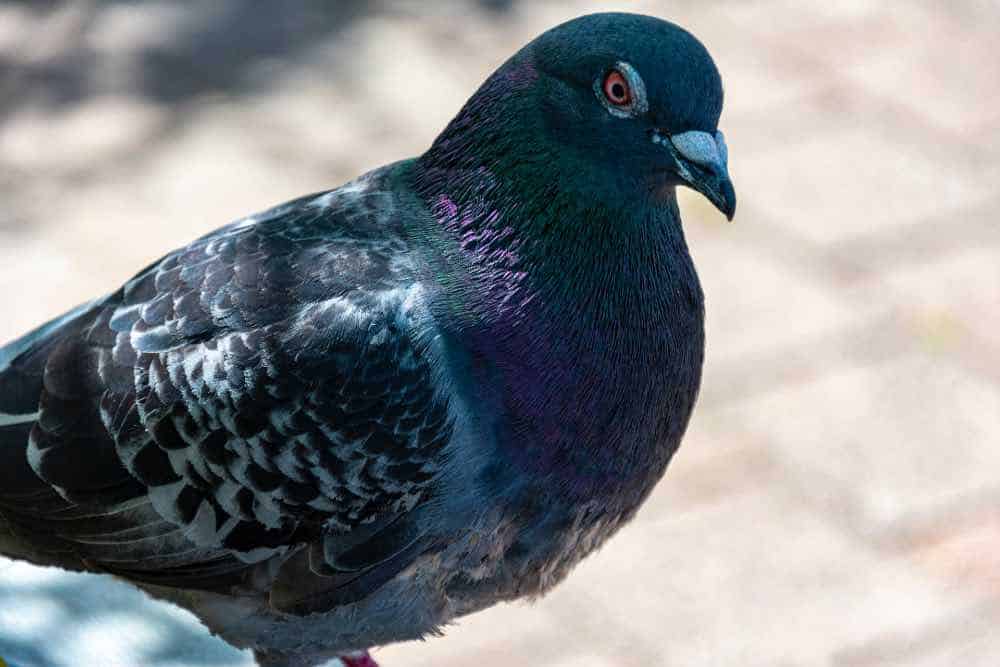
| Appearance | Large bird 12-14″ long, chubby with blue/gray wings with black pointy tips, short red legs, black, round wide tail, and iridescent neck. |
| Diet | Grains, seeds, and fruit. Commonly seen scavenging trash cans for food. |
| Feeder Food | Millet, cracked corn, black-oil sunflower seed, safflower, peanut hearts. |
| Habitat | Common around cities and towns as well as farmlands |
| Nesting | A large nest of sticks and grass wherever there's a ledge (e.g. highway overpass, barns, bridges, tall buildings). 1-6 broods/year, 1-3 eggs/brood, eggs are white, incubation about 18 days and the young fledge at about 25-32 days. |
Range Map
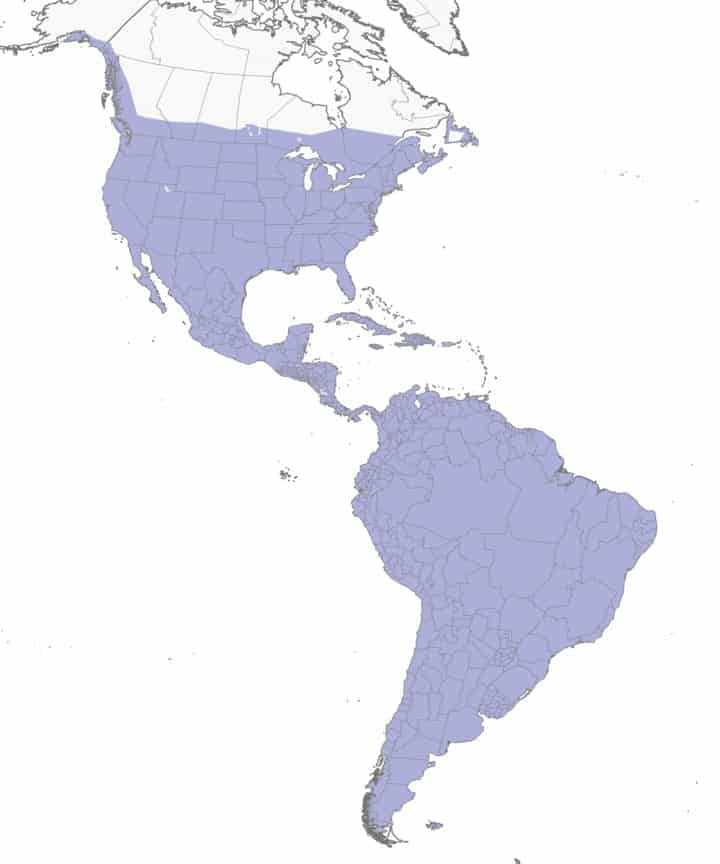
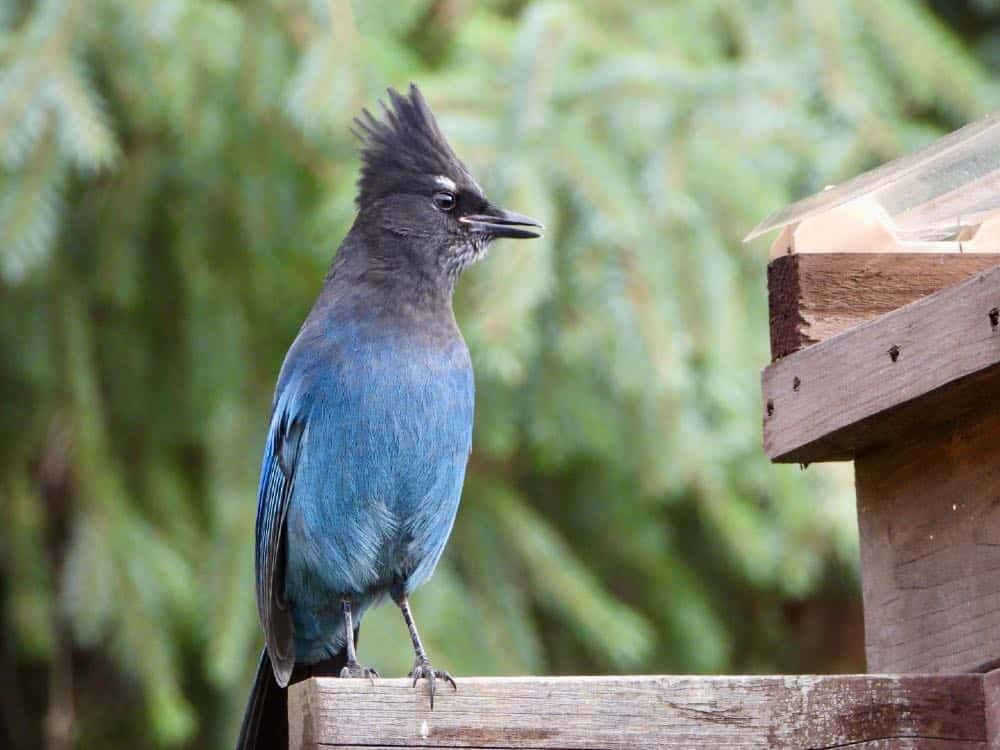
| Appearance | Large bird 11.5″ long, dark blue body and crest, black head and crest with spots of blue. Females are similar. |
| Diet | Nuts, seeds, fruits, insects, other birds' eggs and nestlings, small animals. |
| Feeder Food | Whole peanuts, sunflower seeds, and suet. |
| Habitat | Typically found in forested areas of mix tree types – coniferous and deciduous. |
| Nesting | Large open-cup nest of twigs, bark and mud located high in a conifer tree. 1 brood/season, 4-5 eggs/brood, eggs are blue/green with dark brown/purple/olive spots, 16-18 days incubation and the young fledges at about 16-18 days. |
Range Map
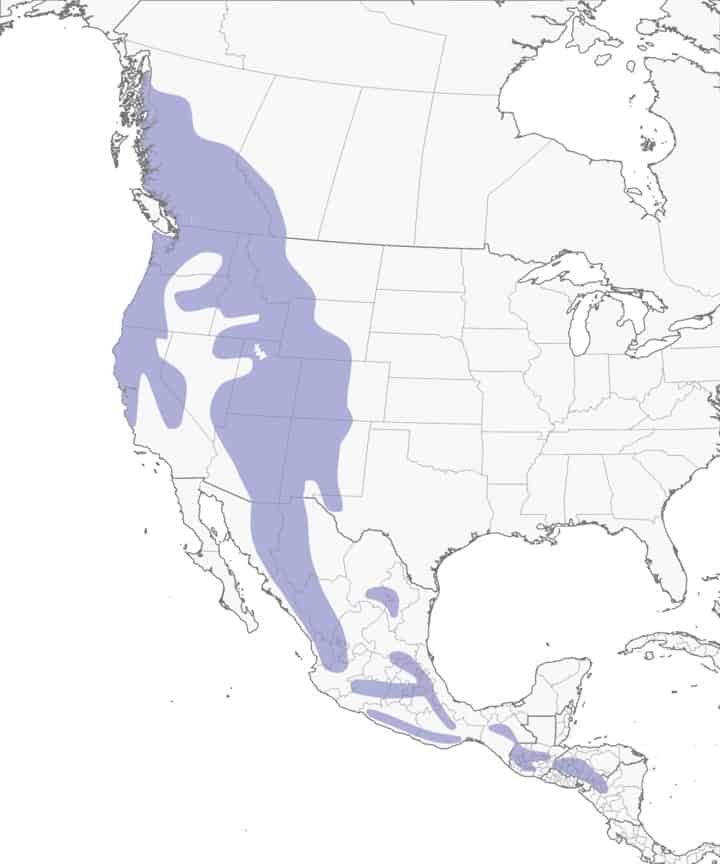
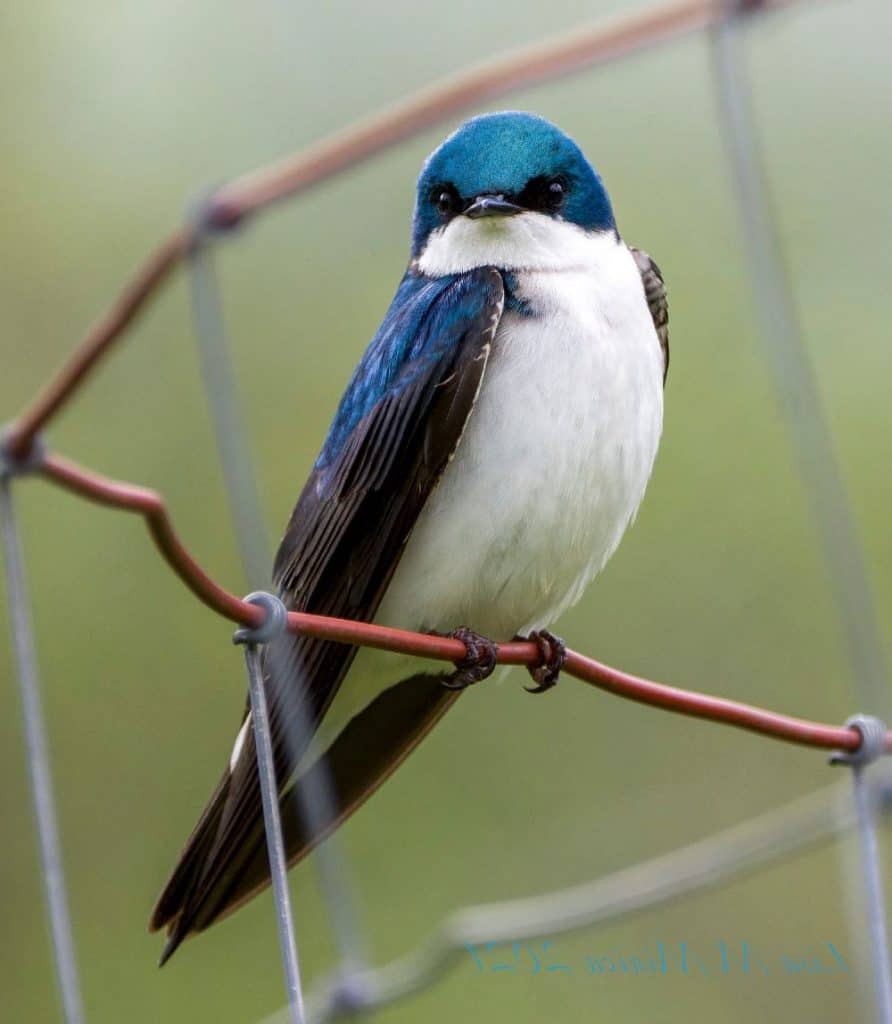
| Appearance | 5-6″ long, dark metallic blue – blue/green with white belly, notched tail and pointed wing tips. Females have same coloring but a bit duller. |
| Diet | Insects and small fruits. |
| Feeder Food | Unlikely to visit a feeder. |
| Habitat | Open areas such as fields, large lawns, and marshes. |
| Nesting | Cavity nester, will use a manmade nest box or natural woodpecker tree hold. 1 brood/season, 4-6 white eggs, 13-16 days of incubation. |
Range Map
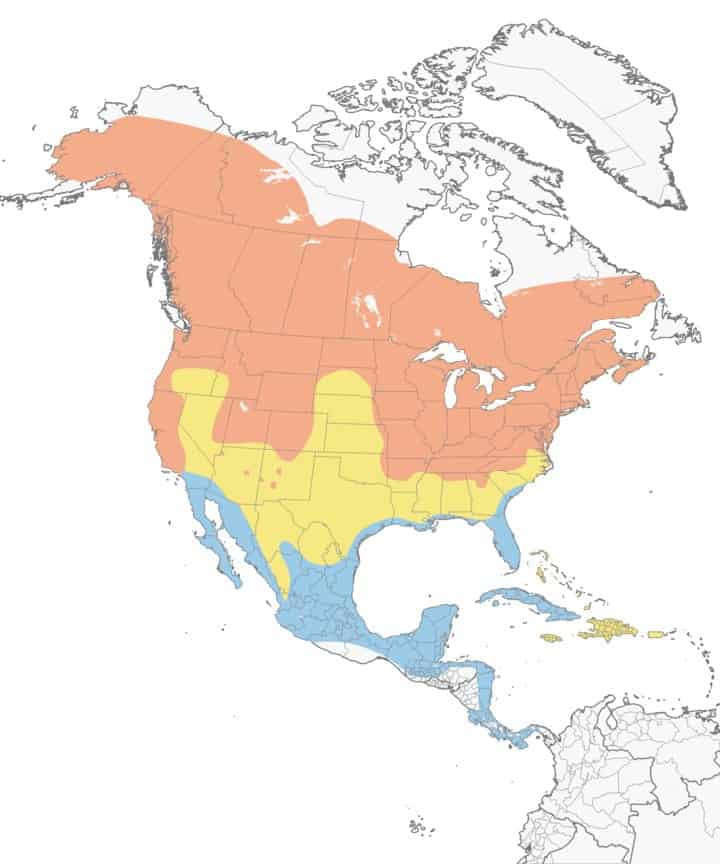
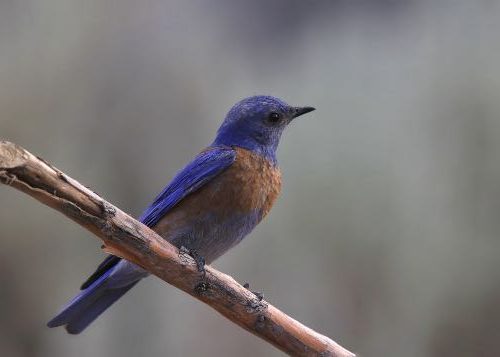
| Appearance | Small bird 7″ long, deep blue underparts, orange-chestnut back and breast. Female gray/blue, light blue wings and tail, and pale chestnut breast. |
| Diet | Insects, fruits & berries. |
| Feeder Food | Mealworms |
| Habitat | Open woodlands especially those with pines and oaks, orchards, and farmland with some trees. |
| Nesting | Nest: Cavity nesters – old woodpecker hold or manmade nesting box. Brood: 2 broods/season Clutch: 4-5 eggs/brood Egg color: Pale blue without blemishes, although sometimes are white Egg size: Length: 0.8-2.4″ x Width: .8″ Incubation: 12-18 days and young fledge at about 20 days. |
Range Map

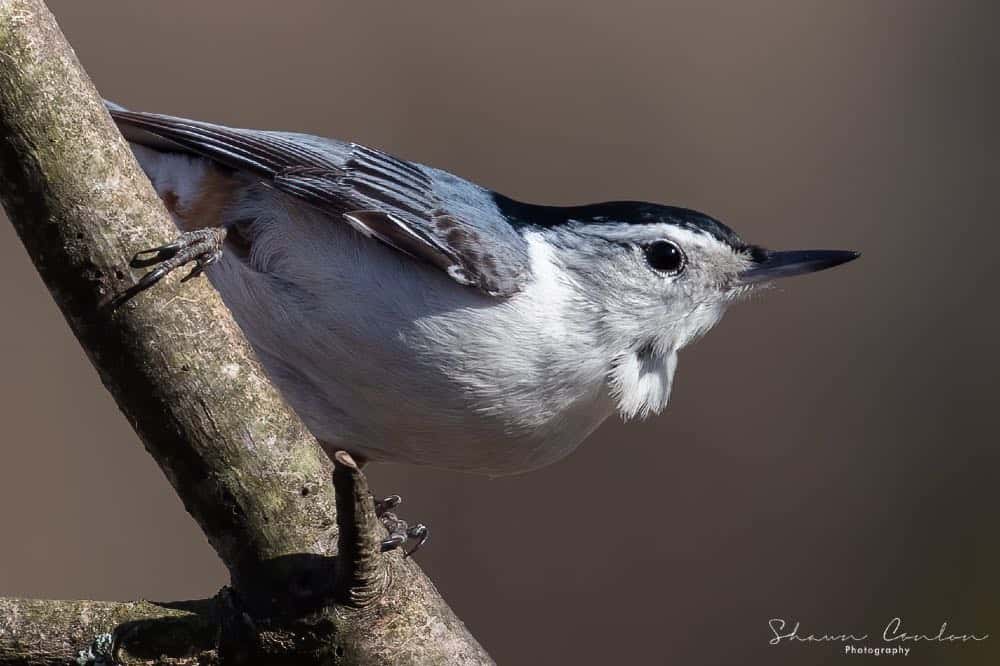
| Appearance | 5-6″ long, gray/blue back, white head with a black cap, chestnut under the tail, and a long thin pick-like beak. Females look similar except their cap and neck are gray. Usually spotted climbing upside-down a deciduous tree foraging for insects beneath the bark. |
| Diet | Insects & seeds. |
| Feeder Food | Suet, sunflower seed, shelled peanuts. |
| Habitat | Near mature deciduous and mixed forests; wooded suburban areas such as orchards, parks, and backyards. |
| Nesting | Cavity nester, 1 brood/season, 5-9 eggs/brood, eggs are white with brown markings, incubation is 11-12 days and young fledge at about 13-14 days. |
Range Map
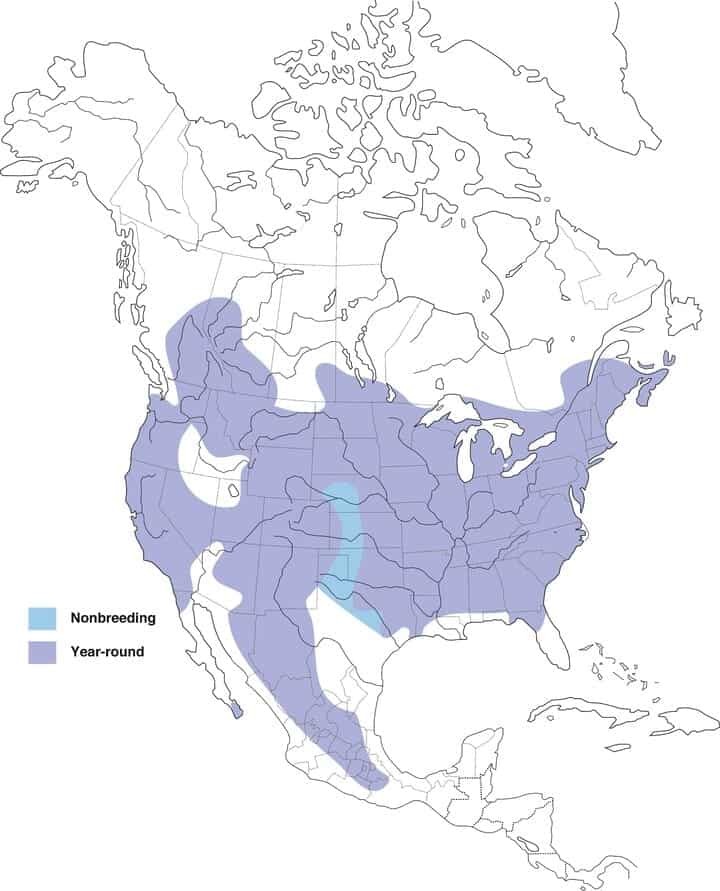
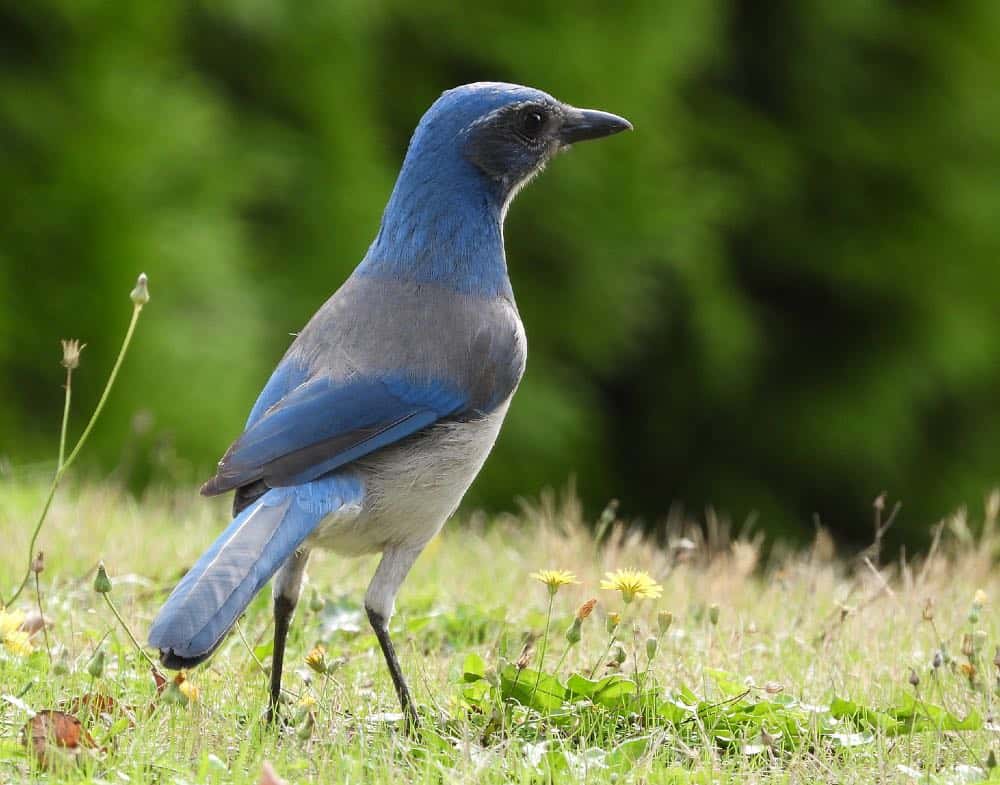
| Appearance | 11-12″ large bird, light blue and gray, white throat, gray belly separated by an indistinct, angled stripe of bright blue on chest, and long wide tail. Female are similar. |
| Diet | Insects, fruit, nuts, seeds, lizards and nestling birds, sometimes finding nests. |
| Feeder Food | Whole peanuts, sunflower seeds. |
| Habitat | Pinyon pine habitats, dry shrublands of Nevada on south, suburbs and parks. |
| Nesting | Basket shaped nest of twigs and plant in pinyon pine or shrub between 6-14′ up. 1-5 eggs, eggs .9-1.3″ long, pale green blotched with olive, or pale gray spotted with brown. Incubation 17-19 days and long fledge 17-19 days. |
Range Map
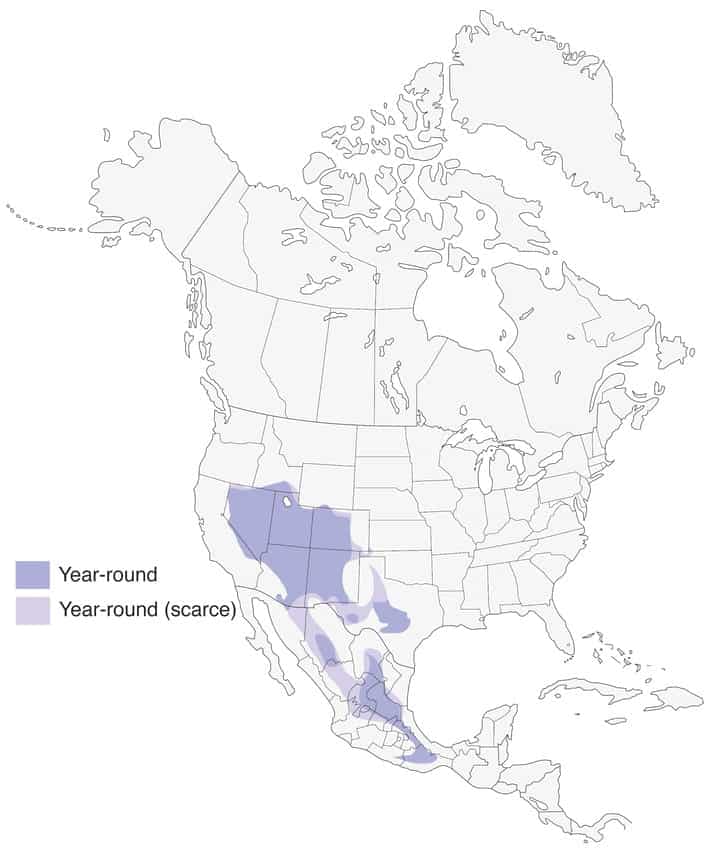
Hopefully, you've identified the blue-colored bird in this article or just broadened your knowledge of blue birds in Texas. If you want to see more blue birds consider taking steps to attract them.
Happy Birding!
Source: https://www.onthefeeder.com/the-ultimate-list-of-blue-colored-birds-in-texas/
0 Response to "Small Blue Bird With White Belly and Crest in San Antonio"
Post a Comment